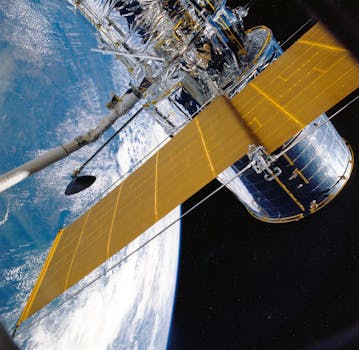GEO Satellites: Understanding the Technology and Applications of Geostationary Earth Orbit Satellites

GEO Satellites: Understanding the Technology and Applications of Geostationary Earth Orbit Satellites
GEO satellites, or geostationary earth orbit satellites, are a type of satellite that orbits the Earth at an altitude of approximately 36,000 kilometers above the equator. At this altitude, the satellite’s orbital period matches the Earth’s rotational period, allowing it to remain stationary relative to a fixed point on the Earth’s surface. This unique characteristic makes GEO satellites an essential component of modern telecommunications, navigation, and weather forecasting systems.
GEO satellites have been in use for several decades, with the first geostationary satellite, Syncom 2, launched in 1963. Since then, the technology has evolved significantly, with advancements in materials, propulsion systems, and payload capacity. Today, GEO satellites play a vital role in providing a wide range of services, including television broadcasting, telecommunications, navigation, and weather forecasting.
How GEO Satellites Work
GEO satellites operate by transmitting and receiving signals to and from Earth-based stations. The satellite’s antenna receives signals from the Earth station, amplifies them, and then re-transmits them back to Earth, where they are received by other Earth stations. This process allows for communication between two distant points on the Earth’s surface, making it possible to transmit data, voice, and video signals over long distances.
The GEO satellite’s orbit is not perfectly circular, which means that its distance from the Earth varies slightly over the course of its orbit. To maintain its position and ensure continuous communication, the satellite must periodically adjust its orbit using small thrusters. This process, known as station-keeping, is crucial to maintaining the satellite’s position and preventing it from drifting out of its assigned orbit.
Applications of GEO Satellites
GEO satellites have a wide range of applications, including television broadcasting, telecommunications, navigation, and weather forecasting. In the field of television broadcasting, GEO satellites are used to distribute channels to cable headends and direct-to-home (DTH) platforms. They are also used to provide telecommunications services, such as voice and data transmission, to remote or underserved areas.
In the field of navigation, GEO satellites are used to provide location information and timing signals to GPS receivers on the ground. This information is used to determine the receiver’s exact location and velocity, making it possible to navigate with high accuracy. Weather forecasting is another critical application of GEO satellites, which are used to collect data on atmospheric conditions, such as temperature, humidity, and cloud cover.
Benefits and Challenges of GEO Satellites
The use of GEO satellites offers several benefits, including global coverage, high bandwidth, and reliability. GEO satellites can provide coverage to a wide area, making them ideal for applications such as television broadcasting and telecommunications. They also offer high bandwidth, which is essential for applications such as video transmission and data transfer.
However, the use of GEO satellites also poses several challenges, including signal latency, interference, and orbital congestion. Signal latency refers to the delay between the time a signal is transmitted and the time it is received, which can be significant for GEO satellites due to their high altitude. Interference from other satellites or terrestrial sources can also be a problem, as it can disrupt the signal and affect the quality of service.
Future of GEO Satellites
The future of GEO satellites looks promising, with several new technologies and applications on the horizon. One of the most significant developments is the use of high-throughput satellites (HTS), which offer higher bandwidth and faster data transfer rates. HTS are expected to play a critical role in the development of 5G networks and other high-bandwidth applications.
Another area of development is the use of electric propulsion systems, which offer higher efficiency and longer mission durations. Electric propulsion systems use electrical energy to accelerate ions or electrons, which are then expelled to create thrust. This technology is expected to become more widespread in the coming years, as it offers several advantages over traditional chemical propulsion systems.



